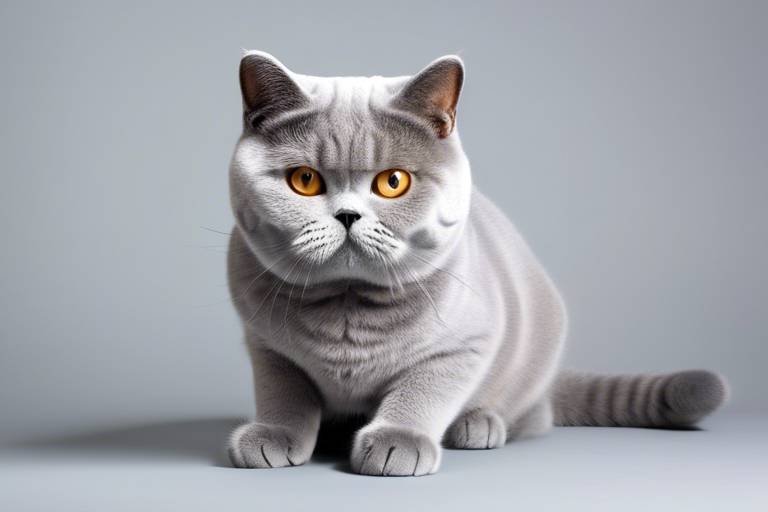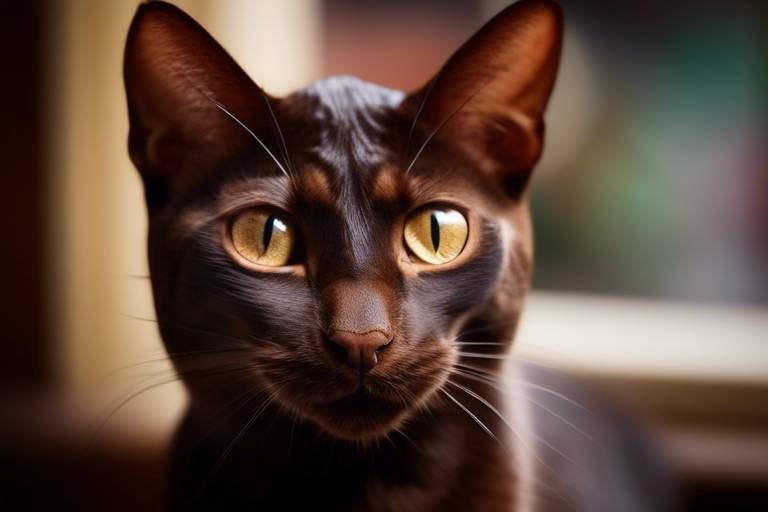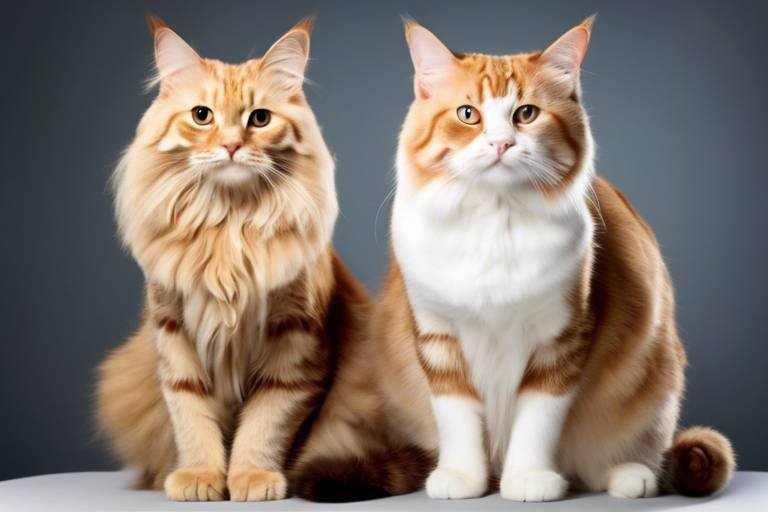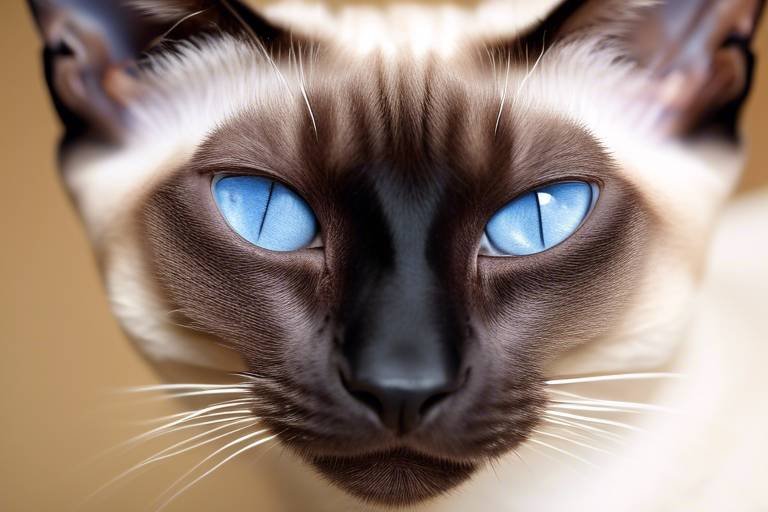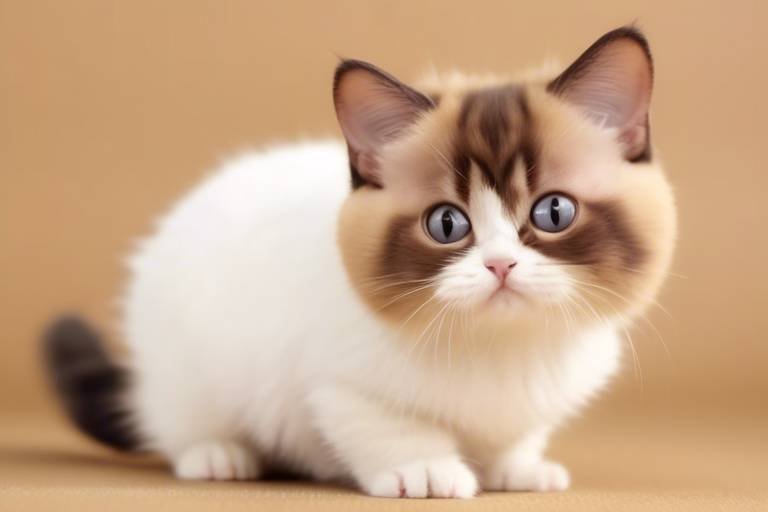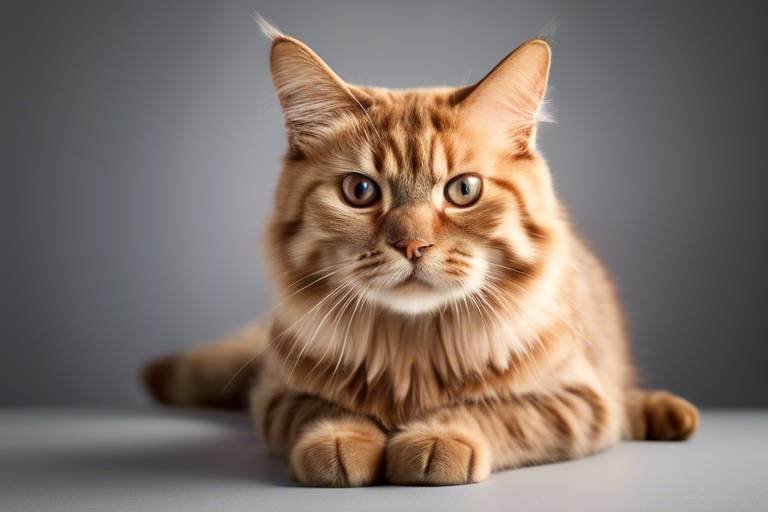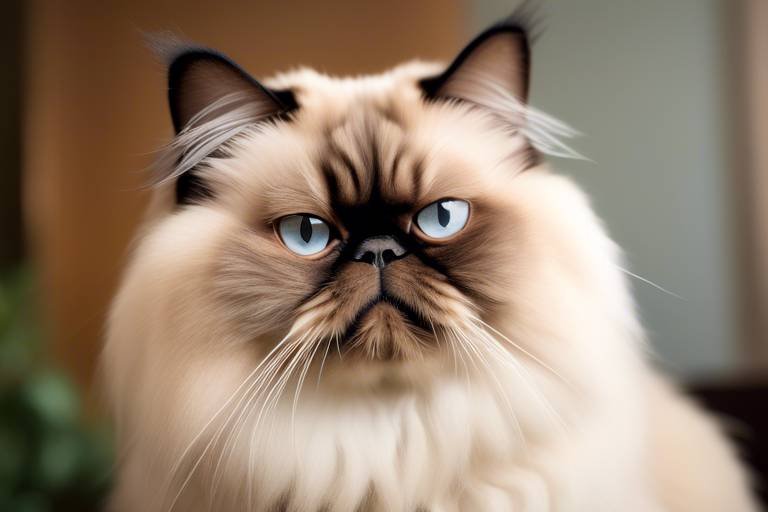The Unique Traits of the British Shorthair Cat
The British Shorthair cat is not just another feline; it's a breed that embodies a rich history and a unique personality that captivates cat lovers around the world. Known for their stocky build and round faces, these cats have a charm that is hard to resist. With their plush coats and vibrant eyes, they have a regal presence that stands out in any home. But it’s not just their looks that make them special; it’s their temperament, intelligence, and adaptability that truly set them apart. In this article, we will explore the distinctive characteristics of the British Shorthair, diving into their physical appearance, personality traits, care needs, and historical background, providing a comprehensive overview for potential cat owners.
The British Shorthair is a breed that commands attention with its robust and muscular physique. These cats are built like little tanks, with broad chests and thick legs that give them a sturdy appearance. Their heads are large and round, featuring chubby cheeks and a short, broad nose. One of the most captivating aspects of the British Shorthair is its coat, which is dense and plush, almost like a soft teddy bear. The breed comes in a variety of colors and patterns, from the classic blue-gray to striking tabbies and even color points.
When it comes to their eyes, British Shorthairs are equally mesmerizing. Their large, round eyes can be gold, copper, or blue, depending on the coat color, and they give the cat an almost innocent expression. This unique combination of features makes the British Shorthair one of the most recognizable and beloved cat breeds. Whether you prefer a solid color or a more patterned coat, there's a British Shorthair to match your aesthetic.
British Shorthairs are renowned for their calm and friendly demeanor. They are not the type of cats that will zoom around the house or demand constant attention. Instead, they are laid-back companions who enjoy spending time with their human families. These cats have a reputation for being affectionate yet independent, striking a perfect balance that many cat owners appreciate. They are known to form strong bonds with their owners, often following them around the house, yet they also value their alone time, making them low-maintenance pets.
Understanding the social behavior of British Shorthairs is crucial for potential owners. These cats are generally good-natured and adapt well to various living situations, whether in a bustling household or a quiet apartment. They tend to get along well with children and other pets, making them ideal companions for families. Their adaptable nature allows them to thrive in different environments, and they are often described as gentle giants due to their calm demeanor and affectionate nature.
Despite their calm demeanor, British Shorthairs enjoy playtime just like any other cat. They have a playful side that often surprises new owners. Engaging them in play can be a great way to bond and keep them mentally stimulated. Recommended toys include feather wands, laser pointers, and interactive puzzle toys that challenge their intelligence. Regular playtime not only helps with their physical fitness but also provides an outlet for their natural hunting instincts.
While British Shorthairs are generally affectionate, it's essential to recognize their moods to maintain a harmonious environment. They are not prone to aggression, but like any animal, they can become overstimulated or annoyed. Understanding their body language is key; for instance, a flicking tail or pinned ears can indicate that they need some space. By respecting their boundaries, you can ensure a loving relationship filled with mutual respect and affection.
British Shorthairs are intelligent cats that can be trained effectively. They respond well to positive reinforcement, making training sessions enjoyable for both the cat and the owner. Teaching basic commands and tricks can be a fun way to engage with your British Shorthair. They are quick learners and can pick up on commands with consistency and patience. Training not only helps in establishing good behavior but also strengthens the bond between you and your furry friend.
Like all breeds, British Shorthairs have specific health concerns that potential owners should be aware of. Common health issues include heart disease, obesity, and dental problems. Regular vet check-ups are crucial for early detection and prevention of these issues. Maintaining a healthy lifestyle through proper diet and exercise is also essential for their well-being.
Proper nutrition is vital for the health of British Shorthairs. They require a balanced diet that meets their energy needs, especially since they can be prone to obesity. High-quality cat food that lists meat as the primary ingredient is recommended. It's also important to establish a feeding schedule to prevent overeating. Regularly monitoring their weight and adjusting their diet accordingly can help keep them healthy and active.
While British Shorthairs are not overly active, they still need regular exercise to maintain their health. Engaging them in playtime and providing climbing structures or scratching posts can help keep them fit. A few short play sessions throughout the day can be beneficial, allowing them to burn off energy without becoming overly stimulated. Remember, a happy cat is a healthy cat!
- What is the average lifespan of a British Shorthair? Typically, they live between 12 to 20 years with proper care.
- Do British Shorthairs shed a lot? They have a dense coat, so regular grooming is recommended to manage shedding.
- Are they good with children? Yes, they are known for their gentle and friendly nature, making them great companions for kids.
- How much exercise do they need? While not overly active, they should have daily playtime to stay healthy.
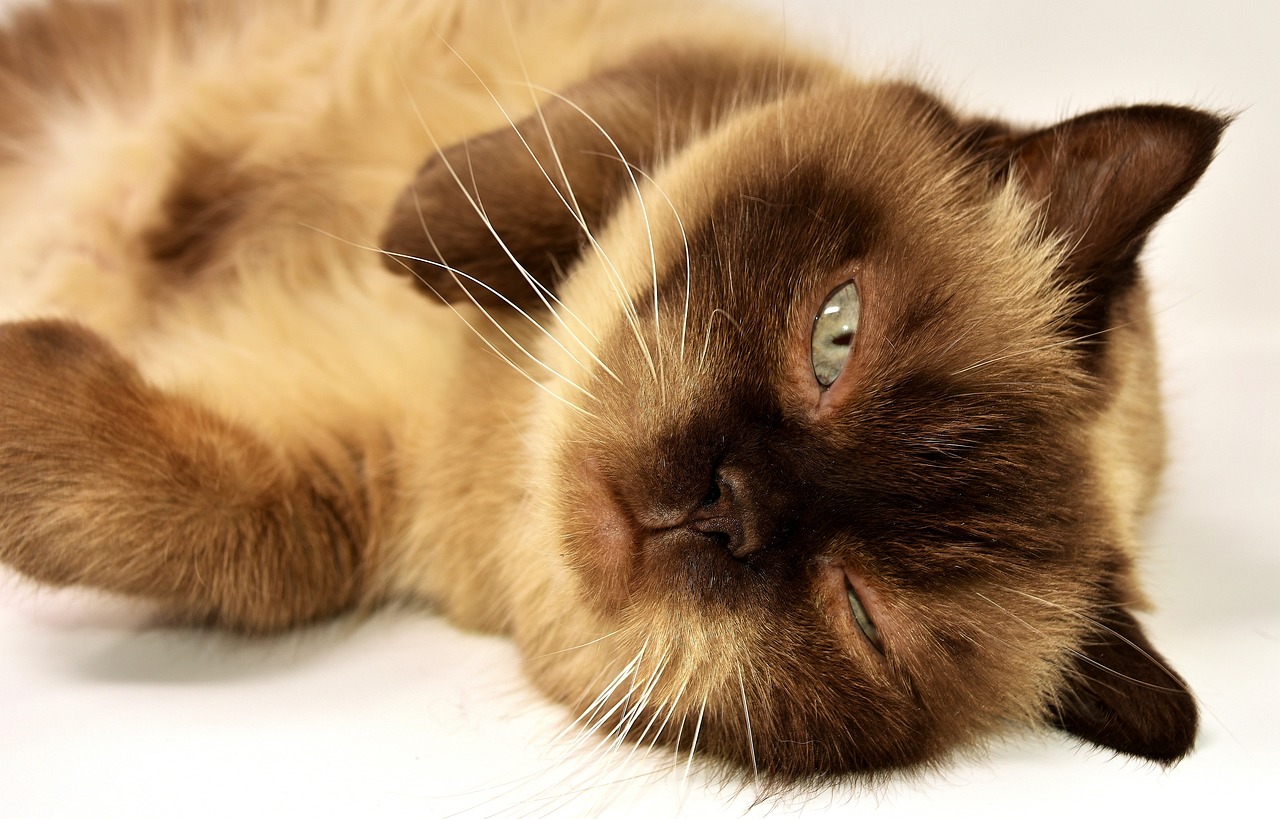
Physical Appearance
The British Shorthair cat is a breed that truly captures the eye with its distinctive and robust physical characteristics. One of the most striking features of this breed is its round face, which is framed by a stocky neck and a broad, muscular body. This combination gives them a solid and sturdy appearance, making them look almost like a small bear! Their short, dense coat comes in a variety of colors and patterns, but the classic blue-grey is perhaps the most recognized. Other popular colors include cream, black, and even tabby variations, showcasing their versatility in appearance.
When it comes to their eyes, the British Shorthair boasts large, round, and expressive eyes that can be copper, blue, or even gold, depending on their coat color. These captivating eyes add to their overall charm and make them incredibly photogenic. Their ears are another notable feature; they are small to medium in size, rounded at the tips, and set wide apart, contributing to their adorable facial structure.
The body structure of a British Shorthair is robust and compact. Males typically weigh between 9 to 17 pounds, while females are slightly smaller, ranging from 7 to 12 pounds. Their powerful legs and broad paws give them a solid foundation, allowing them to move gracefully despite their stocky build. This breed's tail is also noteworthy; it is medium in length and thick at the base, tapering to a rounded tip, which adds to their overall balanced appearance.
To summarize, the British Shorthair's physical appearance can be encapsulated in a few key traits:
- Face: Round and broad
- Coat: Short, dense, and available in various colors
- Eyes: Large and round, with colors ranging from copper to blue
- Body: Stocky, muscular, and compact
- Tail: Medium length, thick at the base, rounded tip
Overall, the British Shorthair is not just a cat; it’s a striking companion that brings a sense of warmth and charm to any household. Their unique appearance, combined with their delightful personality, makes them a favorite among cat lovers worldwide.
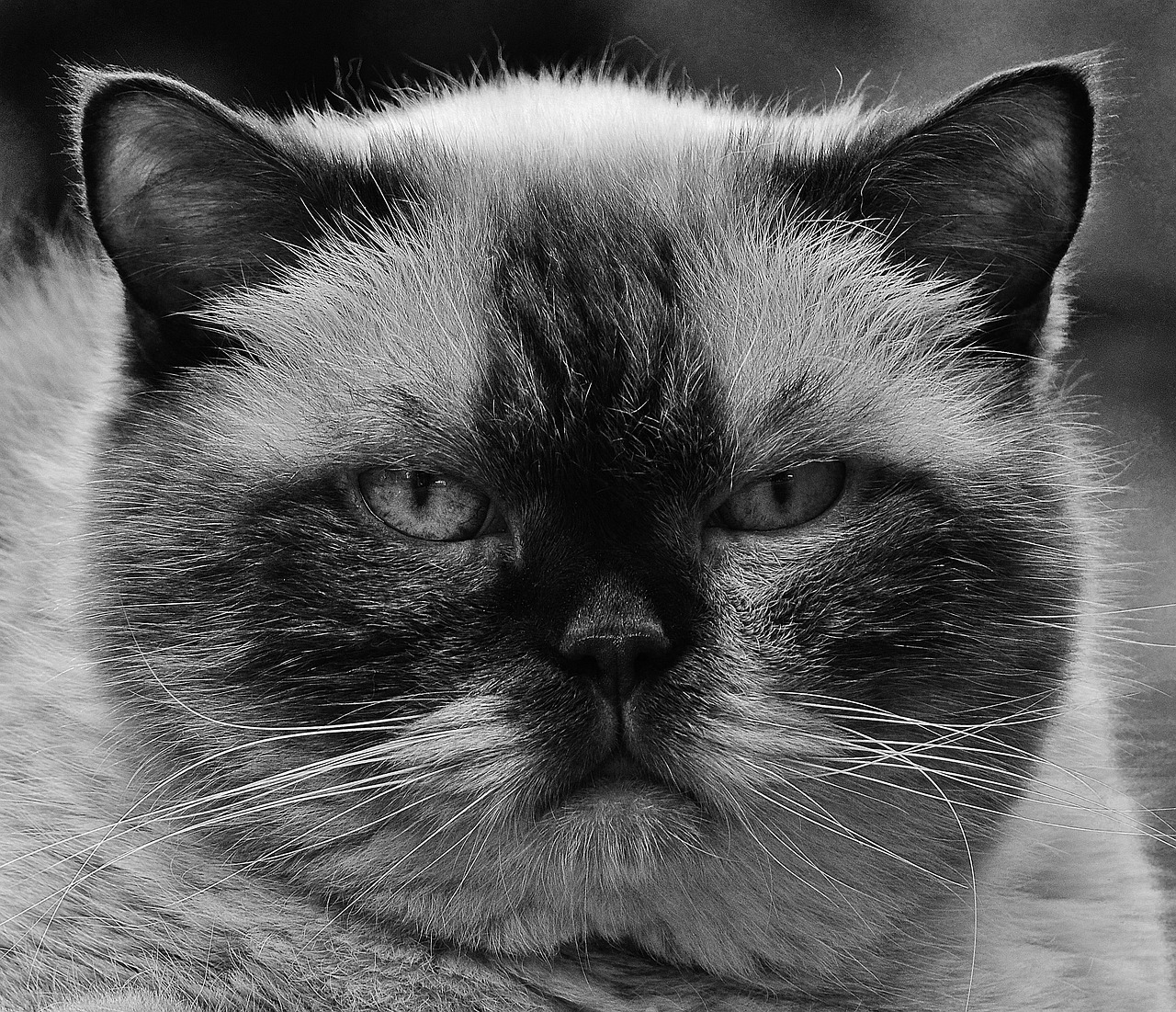
Temperament and Personality
The British Shorthair cat is not just a pretty face; it boasts a personality that matches its charming appearance. Known for their calm and friendly demeanor, these felines make for delightful companions. Imagine coming home after a long day, and there they are, lounging comfortably, ready to greet you with their gentle purring. This breed is often described as affectionate, yet they maintain an air of independence, striking a perfect balance that many cat lovers adore.
One of the most appealing aspects of the British Shorthair is their adaptability. Whether you live in a bustling household filled with children or a quiet apartment, these cats seem to fit right in. They are not overly demanding, which makes them ideal for both families and individuals. Their sociable nature allows them to interact well with other pets, making them a wonderful addition to multi-pet households. It’s like having a furry diplomat in your home, effortlessly bridging the gap between different species!
Understanding the social behavior of British Shorthairs is crucial for potential owners. These cats thrive on companionship but are not clingy. They enjoy being part of the family without being in your face all the time. Imagine them as the cool friend who’s always around but gives you the space you need. They are known to follow their humans from room to room, not out of neediness, but out of genuine curiosity and affection.
When it comes to their relationships with family members, British Shorthairs tend to form strong bonds. They are known for their gentle nature, making them excellent companions for children. However, it’s essential to teach kids how to interact with them respectfully. A gentle pet here and a soft scratch behind the ears there can create a loving atmosphere. In fact, they often become the silent guardians of the household, keeping a watchful eye on the little ones.
Despite their calm demeanor, British Shorthairs have a playful side that can surprise you! They might not be as hyperactive as some breeds, but they enjoy engaging in playtime. Think of them as the seasoned athlete who enjoys a good game now and then. Recommended toys include feather wands, laser pointers, and even simple cardboard boxes. These cats are known for their ability to entertain themselves, but a little interactive playtime with their humans can strengthen your bond.
It’s essential to recognize that British Shorthairs can exhibit a range of emotions. While they are generally affectionate, they can also show signs of aggression if they feel threatened or overstimulated. Understanding their moods is key to ensuring a harmonious environment. Look for subtle cues like tail flicks or flattened ears; these are their ways of communicating discomfort. Creating a safe space where they can retreat when they need a break is crucial. After all, every cat deserves a cozy corner to recharge!
British Shorthairs are not just adorable; they are also quite intelligent. This breed can be trained effectively, which is a delightful surprise for many new cat owners. Techniques such as positive reinforcement work wonders. Imagine teaching your cat to sit or even high-five! It's not just about impressing your friends; it’s about engaging their minds and keeping them mentally stimulated. The more you challenge them, the more they thrive.
In conclusion, the British Shorthair's temperament and personality are a beautiful blend of affection, independence, and intelligence. They are like the wise old soul of the cat world, offering companionship without overwhelming you. If you're considering bringing one into your home, be prepared for a loving friend who will charm you with their playful antics and calm presence.
- Are British Shorthairs good with children?
Yes, they are known for their gentle nature and can be great companions for kids when properly socialized. - Do they require a lot of attention?
While they enjoy companionship, British Shorthairs are independent and do not require constant attention. - How do I keep my British Shorthair entertained?
Engage them with interactive toys, play sessions, and puzzle feeders to keep their minds sharp. - What is their grooming needs?
British Shorthairs have a dense coat that requires regular brushing to minimize shedding.
Social Behavior
The social behavior of the British Shorthair is one of the many reasons why this breed has captured the hearts of cat lovers around the world. These cats are not just solitary creatures; they thrive on companionship and have a unique way of interacting with their human families and other pets. Imagine coming home after a long day, and your British Shorthair greets you at the door with a gentle purr and a nuzzle. This affectionate nature makes them excellent companions, especially for families with children or other pets.
British Shorthairs are known for their adaptability. They can easily adjust to various living situations, whether it’s a bustling household or a quieter environment. Their calm demeanor allows them to coexist peacefully with other pets, and they often form strong bonds with their human family members. You might find them lounging next to you on the couch, enjoying the warmth of your presence, or following you from room to room, curious about your every move. This breed is particularly known for its gentle disposition, making them less likely to exhibit aggressive behaviors compared to some other breeds.
When it comes to their interactions with children, British Shorthairs tend to be very patient and tolerant. They understand that little hands may not always be gentle, and they often allow children to play with them without showing signs of irritation. This makes them a great choice for families. However, it’s essential to teach children how to interact with cats respectfully to ensure a harmonious environment. Additionally, British Shorthairs can be quite vocal, using soft meows and trills to communicate their needs and desires, which adds a delightful charm to their personality.
In terms of socialization, early exposure to different environments, people, and pets can help British Shorthairs develop into well-rounded adults. They may not be as hyperactive as some breeds, but they do enjoy engaging with their human companions. Activities such as interactive play sessions using feather wands or laser pointers can help stimulate their minds and reinforce the bond between cat and owner. It's crucial to provide them with toys that challenge them mentally and physically, as this breed enjoys a bit of fun while also being quite laid-back.
In summary, the social behavior of the British Shorthair is characterized by their affectionate nature, adaptability, and gentle demeanor. They thrive in a social environment and are known to be excellent companions for families and individuals alike. Understanding their social needs can lead to a fulfilling relationship, making them a cherished member of any household.
- Are British Shorthairs good with children?
Yes, their gentle and patient nature makes them great companions for children. - Do British Shorthairs get along with other pets?
Typically, they are very adaptable and can coexist peacefully with other pets. - How can I help my British Shorthair socialize?
Early exposure to various environments and gentle interactions with different people and pets can enhance their social skills.
Playfulness
When you think of the British Shorthair, you might picture a dignified and composed feline, lounging regally in a sunbeam. However, beneath that calm exterior lies a surprisingly playful spirit that can catch you off guard! These cats are not just about napping and looking cute; they have a playful side that can bring joy and laughter to any household. Just like a child who surprises you with their boundless energy, British Shorthairs can spring into action when the mood strikes them.
One of the most delightful aspects of their playfulness is how it manifests in various forms. Whether it’s chasing after a feather toy, pouncing on a laser dot, or engaging in a good old-fashioned game of hide and seek, these cats know how to keep things entertaining. Their playful antics can often be reminiscent of a miniature lion stalking its prey, showcasing both their hunting instincts and their charming personality.
To keep your British Shorthair mentally stimulated and physically active, it’s essential to provide them with a variety of toys. Here are some popular options:
- Interactive Toys: Toys that require your cat to think and engage, such as puzzle feeders, can be particularly stimulating.
- Wand Toys: These allow you to play together, mimicking the hunting experience and strengthening your bond.
- Catnip Toys: Many British Shorthairs love catnip, which can make playtime even more exciting.
Furthermore, it’s important to schedule regular play sessions. Think of it as a daily workout for your cat. Just like humans, cats need exercise to stay healthy and happy. Aim for at least 15-20 minutes of active play each day. This not only keeps them fit but also helps to prevent behavioral issues that can arise from boredom.
Incorporating play into your British Shorthair’s daily routine can lead to a happier, more well-adjusted pet. It’s a win-win situation! So, grab that feather wand and get ready to unleash your cat’s inner playful lion. You’ll be amazed at how much joy and laughter a little playtime can bring to your home!
Aggression and Affection
The British Shorthair is often celebrated for its gentle temperament and loving nature, but like any breed, they can exhibit a mix of affection and aggression depending on their mood and environment. Understanding this balance is crucial for any potential owner. You see, these cats are not just fluffy companions; they are complex beings with their own emotional landscapes. Imagine a calm lake that can suddenly ripple with waves—this is much like the British Shorthair's personality.
When it comes to affection, British Shorthairs are known to be affectionate without being overly clingy. They enjoy cuddling and being close to their humans, often following them around the house like a loyal shadow. Yet, they also appreciate their personal space and will let you know when they need some alone time. This independent streak means they are often content to lounge in a sunny spot while you go about your day, but they will eagerly join you for some quality snuggle time when the mood strikes.
On the flip side, aggression can sometimes rear its head, especially if a British Shorthair feels threatened or overstimulated. For example, if your furry friend is enjoying a good petting session but then suddenly swats at your hand, it’s likely a sign that they’ve had enough. This behavior is often a result of their playful nature, and it’s essential to recognize the signs that indicate when they need a break. Here are a few key signs to watch for:
- Tail twitching or flicking
- Flattened ears
- Sudden stillness or freezing
- Growling or hissing sounds
By being attentive to these cues, you can create a harmonious environment that respects your British Shorthair’s needs. Another important aspect of managing aggression is to engage in regular playtime. Interactive toys, such as feather wands or laser pointers, can help channel their energy positively, allowing them to express their natural hunting instincts without resorting to unwanted behaviors.
Ultimately, fostering a loving relationship with your British Shorthair involves a delicate balance of understanding their moods and preferences. Encourage affection through gentle handling and positive reinforcement, while also allowing them the freedom to express themselves. With patience and love, you’ll find that your British Shorthair is not just a pet, but a cherished member of your family.
- Do British Shorthairs get along with other pets? Yes, they are generally friendly and can adapt well to living with other animals.
- How can I tell if my British Shorthair is feeling aggressive? Look for signs like flattened ears, a twitching tail, or sudden swatting.
- What’s the best way to play with my British Shorthair? Use interactive toys that mimic hunting behaviors to keep them engaged and active.
Training and Intelligence
The British Shorthair is not just a pretty face; they are also surprisingly intelligent and can be trained effectively. Imagine having a cat that not only knows how to sit on command but also enjoys engaging in playful activities that stimulate their mind. This breed is known for its ability to learn quickly, making them excellent candidates for various training techniques. One of the most effective methods is positive reinforcement, where you reward your cat with treats or praise when they perform a desired behavior. Not only does this create a bond between you and your furry friend, but it also encourages them to repeat those behaviors.
When it comes to teaching commands or tricks, consistency is key. British Shorthairs thrive on routine, so establishing a regular training schedule can yield great results. Start with simple commands like "come" or "stay," and gradually introduce more complex tricks as they become more comfortable. Their natural curiosity and playful nature make them eager learners, so don’t be surprised if they pick up on things faster than you expected!
In addition to basic commands, British Shorthairs can benefit from interactive toys that challenge their intellect. Puzzle feeders, for example, can be a fantastic way to keep them mentally stimulated while also rewarding them with treats. These toys not only provide entertainment but also encourage problem-solving skills, allowing your cat to exercise their mind while having fun. It’s essential to provide a mix of physical and mental activities to ensure a well-rounded development.
Moreover, understanding your cat's personality is crucial in the training process. Some British Shorthairs may be more independent than others, which means they might not always be in the mood to learn. Patience is vital; if your cat seems uninterested, it’s best to take a break and try again later. Also, keep in mind that every cat is unique, and what works for one might not work for another. Tailoring your approach based on their responses can make a significant difference in the success of your training sessions.
To summarize, training a British Shorthair can be a rewarding experience for both the cat and the owner. With the right techniques, a bit of patience, and a lot of love, you can teach your feline friend to perform tricks, follow commands, and engage in stimulating activities that cater to their intelligent nature. Remember, the journey of training is as important as the destination, so enjoy the process and cherish the moments spent together.
- Can British Shorthairs be trained to use a litter box?
Absolutely! British Shorthairs are generally very clean cats and can be easily trained to use a litter box. - What kind of tricks can I teach my British Shorthair?
You can teach them basic commands like "sit," "stay," and even more complex tricks like "high five" or "roll over." - How often should I train my British Shorthair?
Short and frequent training sessions, around 5-10 minutes a day, are usually most effective. - Are British Shorthairs good with children?
Yes, they tend to be very gentle and tolerant, making them great companions for kids.
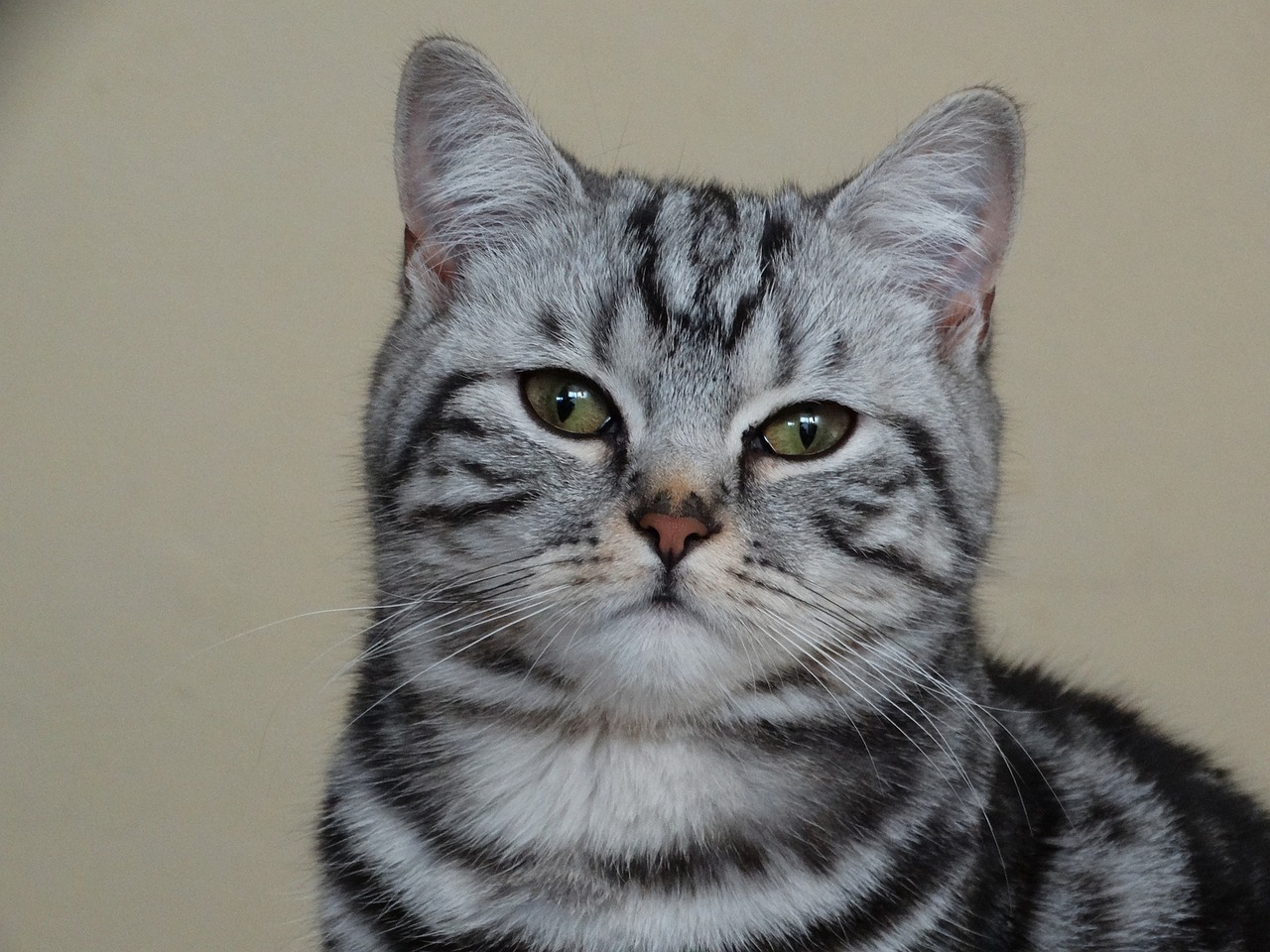
Health Considerations
When it comes to the health of your British Shorthair, understanding their unique needs is essential for ensuring a long and happy life. Like any breed, British Shorthairs are predisposed to certain health issues, but with proper care and attention, many of these can be managed effectively. Regular veterinary check-ups play a crucial role in monitoring their health, allowing for early detection of potential problems. It's important to establish a good relationship with your vet, as they can provide invaluable guidance tailored to your cat's specific needs.
One of the most common health concerns in British Shorthairs is obesity. Their stocky build can make it easy for them to gain weight, which can lead to serious issues like diabetes and joint problems. To combat this, it's essential to maintain a balanced diet and ensure they get enough exercise. A combination of high-quality cat food and controlled portions can help keep their weight in check. Additionally, regular playtime is vital. Engaging them in interactive games not only helps with their physical fitness but also stimulates their minds.
Another health issue to be aware of is hypertrophic cardiomyopathy (HCM), a genetic condition that affects the heart muscle. Regular veterinary check-ups can help in early diagnosis, and your vet may recommend specific tests if there’s a family history of heart disease. Being proactive in monitoring your cat’s health can make a significant difference. Also, pay attention to any signs of lethargy, difficulty breathing, or changes in appetite, as these could signal underlying issues.
Here’s a quick overview of some common health concerns for British Shorthairs:
| Health Concern | Description | Preventive Measures |
|---|---|---|
| Obesity | Excess weight leading to diabetes and joint issues. | Balanced diet and regular exercise. |
| Hypertrophic Cardiomyopathy (HCM) | Genetic heart condition affecting heart muscle. | Regular vet check-ups and monitoring symptoms. |
| Dental Issues | Common in older cats, can lead to pain and infection. | Regular dental care and check-ups. |
In addition to these health considerations, it's vital to focus on their dental health. British Shorthairs can be prone to dental issues, especially as they age. Regular brushing and dental treats can help keep their teeth clean and healthy. You might want to consult your vet for recommendations on the best dental care practices for your feline friend.
Overall, the key to maintaining the health of your British Shorthair lies in a combination of proper nutrition, regular exercise, and routine veterinary care. By staying informed and proactive, you can help ensure that your cat lives a healthy, happy life.
- How often should I take my British Shorthair to the vet?
It’s recommended to have a check-up at least once a year, or more frequently if your cat has any existing health issues. - What should I feed my British Shorthair?
A high-quality, balanced diet is crucial. Look for cat food that lists meat as the first ingredient, and consider consulting your vet for specific recommendations. - How can I help my British Shorthair lose weight?
Reduce portion sizes, avoid overfeeding, and increase playtime to encourage more activity. - Are British Shorthairs prone to any genetic diseases?
Yes, they can be predisposed to conditions such as hypertrophic cardiomyopathy (HCM), so regular vet check-ups are important.
Dietary Needs
The dietary needs of British Shorthair cats are crucial to their overall health and well-being. To keep these charming felines in tip-top shape, it’s essential to provide them with a balanced diet that caters to their unique requirements. Just like you wouldn’t fuel a sports car with regular gas, you shouldn’t compromise on the quality of food you offer your British Shorthair. These cats thrive on a diet rich in protein, which supports their muscular build and energy levels.
When selecting food for your British Shorthair, look for high-quality commercial cat food that lists real meat as the first ingredient. Ingredients like chicken, turkey, or fish are excellent choices, as they provide the necessary amino acids that cats need. Additionally, it’s wise to avoid foods with excessive fillers, artificial preservatives, or by-products, as these can lead to health issues in the long run.
To give you a clearer picture, here’s a quick breakdown of the dietary components that should be included in your British Shorthair's meals:
| Nutrient | Description | Sources |
|---|---|---|
| Protein | Essential for muscle growth and repair | Chicken, turkey, fish, beef |
| Fat | Provides energy and supports skin and coat health | Fish oil, chicken fat |
| Carbohydrates | Provides energy and aids digestion | Brown rice, peas, sweet potatoes |
| Vitamins & Minerals | Supports overall health and immune function | Fruits and vegetables, supplements |
Feeding your British Shorthair two to three meals a day is generally recommended. This helps to maintain their energy levels and prevents obesity, which can be a concern for this breed. You might be wondering about treats—while it’s okay to indulge them occasionally, moderation is key. Treats should not make up more than 10% of their daily caloric intake. Aim for healthy options like freeze-dried meat or small amounts of cooked vegetables.
Another important aspect of their diet is hydration. British Shorthairs are prone to urinary tract issues, so ensuring they have access to fresh water at all times is vital. Some owners find that their cats prefer wet food, as it contains higher moisture content. This not only helps keep them hydrated but also adds variety to their meals.
In summary, providing a well-balanced diet tailored to the specific needs of British Shorthairs is essential for their health and longevity. By focusing on high-quality ingredients and maintaining a consistent feeding schedule, you can ensure that your feline friend remains happy, healthy, and full of life.
- What is the best food for a British Shorthair?
High-quality cat food with real meat as the first ingredient is ideal. Look for brands that provide a balanced mix of protein, fats, and carbohydrates.
- How often should I feed my British Shorthair?
Feeding them two to three meals a day is recommended to maintain their energy levels and prevent obesity.
- Are treats okay for British Shorthairs?
Yes, but they should be given in moderation. Treats should not exceed 10% of their daily caloric intake.
- Do British Shorthairs need wet food?
While not necessary, wet food can help with hydration and is often more palatable for cats.
Exercise Requirements
When it comes to the British Shorthair, you might think that their calm disposition means they don’t need much exercise. However, this breed, while not overly energetic, still requires regular physical activity to maintain their health and happiness. Just like us, cats need to stretch their legs and keep their bodies active to stay fit and avoid obesity. Think of exercise as a way to keep their internal engine running smoothly!
Generally, British Shorthairs benefit from around 20 to 30 minutes of exercise each day. This can be broken up into shorter sessions throughout the day, making it easier for both you and your furry friend. Engaging them in playtime is not only important for their physical health but also stimulates their minds. After all, a bored cat is often a mischievous cat!
So, what are some great ways to keep your British Shorthair active? Here are a few suggestions:
- Interactive Toys: Toys that require your cat to think and move, like feather wands or laser pointers, are fantastic for keeping them engaged.
- Cat Trees: Investing in a cat tree can provide your British Shorthair with a place to climb, scratch, and explore, offering both physical and mental stimulation.
- Hide and Seek: Hide treats around the house for your cat to find. This not only encourages them to move but also engages their natural hunting instincts.
Additionally, incorporating some form of routine into their exercise regimen can be beneficial. Cats are creatures of habit, and they thrive on consistency. Try setting aside specific times each day for play sessions. This routine not only helps you remember to engage with your cat but also gives them something to look forward to.
It’s essential to watch for signs of fatigue or disinterest. If your British Shorthair seems to tire quickly or shows no interest in play, it may be time to switch things up. Sometimes, a simple change in toys or the environment can reignite their enthusiasm for exercise. Remember, keeping your cat active is a teamwork effort; it’s about finding what works best for both of you!
In conclusion, while British Shorthairs may not be the most hyperactive breed, they still require regular exercise to stay healthy and happy. By incorporating playtime into your daily routine, you can help your feline friend lead a balanced life. Just think of it as a way to strengthen your bond and ensure that your cat remains a vibrant part of your family for years to come.
Q: How much exercise does a British Shorthair need daily?
A: British Shorthairs typically need about 20 to 30 minutes of exercise each day, which can be broken into shorter sessions.
Q: What are some good toys for British Shorthairs?
A: Interactive toys like feather wands, laser pointers, and puzzle feeders are great for stimulating their minds and keeping them active.
Q: How can I tell if my British Shorthair is getting enough exercise?
A: Look for signs of a healthy weight, energy levels, and playfulness. If your cat seems lethargic or is gaining weight, it might be time to increase their activity.
Q: Can I take my British Shorthair for walks?
A: While some British Shorthairs may enjoy leash training, many prefer indoor play. It's essential to assess your cat's comfort level with the outdoors.
Frequently Asked Questions
- What are the key physical traits of a British Shorthair?
The British Shorthair is easily recognizable by its robust build, round face, and dense coat. They come in various colors, with the classic blue-gray being the most famous. Their eyes are typically large and round, adding to their charming appearance.
- How would you describe the temperament of a British Shorthair?
British Shorthairs are known for their calm and friendly demeanor. They tend to be affectionate yet independent, making them great companions. Their adaptable nature allows them to fit well into various household environments, whether with families or individuals.
- Are British Shorthairs good with children and other pets?
Absolutely! British Shorthairs are generally gentle and tolerant, which makes them suitable for homes with children and other pets. They enjoy social interactions and can adapt quickly to different family dynamics.
- What kind of toys do British Shorthairs enjoy?
Despite their calm nature, British Shorthairs love to play! They enjoy toys that stimulate their hunting instincts, such as feather wands, laser pointers, and interactive puzzle toys. Regular playtime helps keep them mentally and physically active.
- Can British Shorthairs be trained easily?
Yes, they can! British Shorthairs are quite intelligent and respond well to training. Using positive reinforcement techniques, you can teach them basic commands and even some fun tricks. Consistency and patience are key!
- What are the common health issues for British Shorthairs?
Like any breed, British Shorthairs can be prone to specific health issues, such as hypertrophic cardiomyopathy and obesity. Regular vet check-ups and a balanced diet are crucial for maintaining their health and addressing any potential problems early.
- What should I feed my British Shorthair?
Providing a high-quality diet is essential for your British Shorthair's health. Look for cat food that is high in protein and low in fillers. It's also important to establish a consistent feeding schedule to help manage their weight and overall well-being.
- How much exercise do British Shorthairs need?
While they aren't the most active breed, British Shorthairs still require regular exercise to stay healthy. Aim for short play sessions throughout the day, incorporating activities that encourage them to move and engage their minds.

